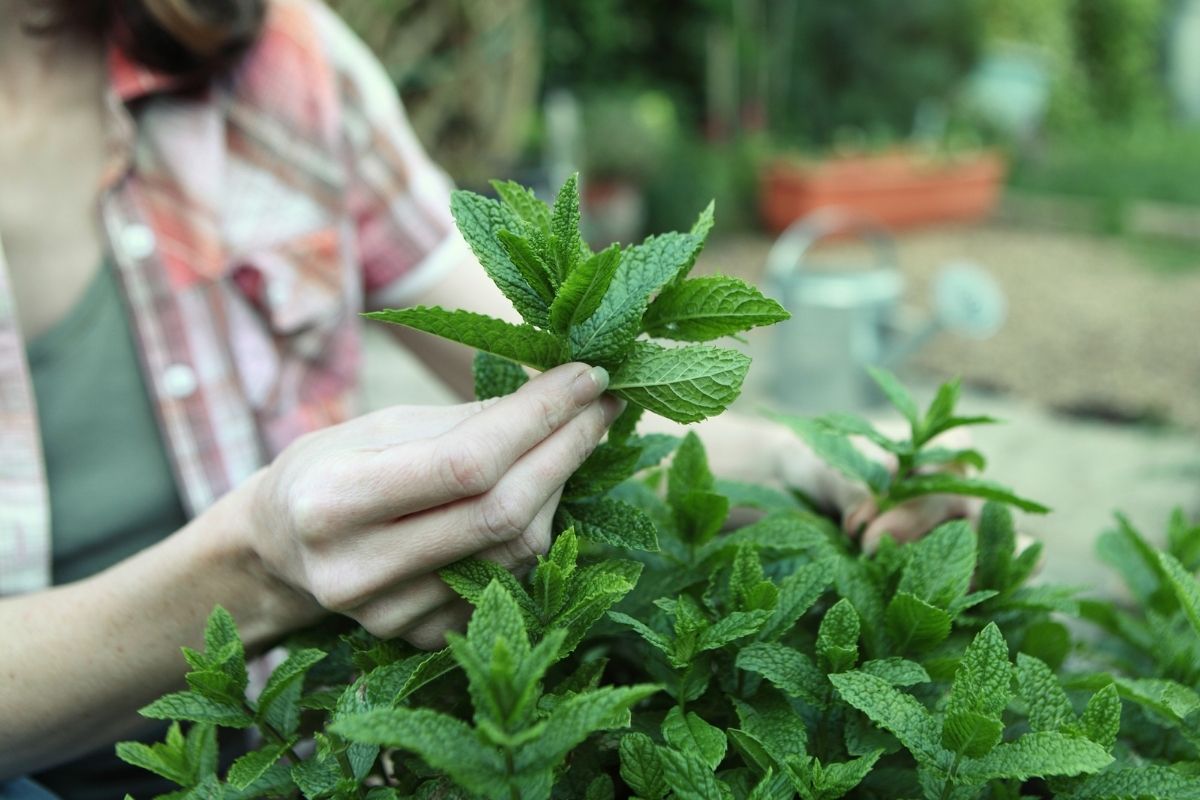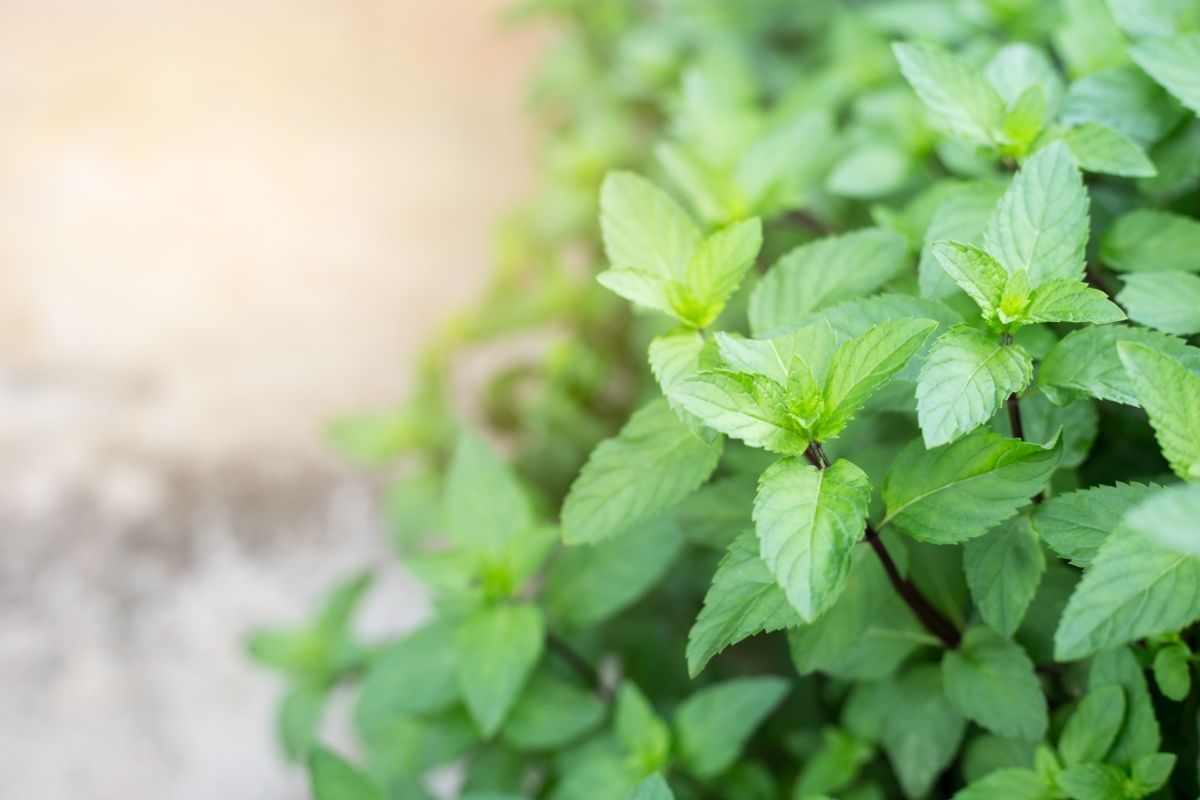Pruning mint is one of the most pleasant tasks on any gardener’s to-do list. Each time you cut the stem, you get a fresh burst of minty perfume that smells wonderful and feels invigorating.
Most gardeners recommend that you focus on two aims when you prune mint. Firstly, to prevent it from flowering and then dropping seeds as this will dramatically reduce the potency of the mint leaves. You will also need to prune to keep the bed healthy.
Many people grow mint to use in cooking or other therapeutic applications. With this in mind, you should never be afraid to pinch off some leaves whenever you need them. If, however, you need a big batch, we recommend that you wait until you can give your mint plant a good prune.
But how do you prune mint? Pruning incorrectly can cause damage to the plant and make it unhealthy. Keep reading to find out everything you need to know about pruning mint – from how and when to do it, and some quick tips to make the job easier.

When Do You Prune Mint?
To prevent a leggy plant with scraggly leaves that are coarse with no flavor, you need to prune in the summer. We recommend that you do a ‘big chop’ around this time to encourage as much new growth as possible and new leaves in the next growing season.
By ‘big chop,’ we mean that you cut back a lot more than you normally would. It may even be necessary for you to cut your mint plant back to the ground or back to the soil. Remember that this is a one-off prune and not something that should be done regularly!
If your mint plant is well maintained, regular pruning is necessary but can be done through harvesting the leaves for use in cooking or therapeutic practices. Try to pinch the stalks to a similar level – for a neat and compact plant, aim for 4 inches of stalk.
How Do You Prune Mint?
You should never be afraid to prune your mint plant – pruning will help keep it healthy and growing quickly.
How to prune:
- Using clean and sharp shears, trim away the top of the stems to remove a maximum of half of your mint plant’s height. Leggy or overgrown mint can be cut back to an inch above the soil level.
- If you do notice any particularly overgrown or leggy limbs on your mint plant, cut these back immediately. You should cut these stems so that they are shorter than the bulk of the plant.
- If you choose to let your mint bloom, deadhead regularly to remove dead flowers. You can also cut off the top 2 to 4 inches of the stem as this will encourage new foliage underneath.
- Once pruned, you need to water your mint. It is generally recommended that you use rainwater as this will be less acidic or chalky than tap water. Water until you can see the excess running out the bottom of the pot.
Can You Prune Mint To Keep It Growing?
Regular pruning will help guarantee a regular turnover of fresh and leafy growth of your mint plant. That said, it is better for the overall health of the plant to not be pruned back by more than a third of its original mass. Pruning severely causes stress to the plant and will limit its leaf production.
Once your mint is well established in your garden or its pot, we recommend that you prune it once a week. This is enough to keep the plant looking tidy and produce lots of fresh leaves, but not so often that your mint will get upset.
How Do You Harvest Mint Leaves?
Mint is an aromatic herb. This means the leaves are packed full of essential oils that produce wonderful minty aromas. In turn, this means you need to be careful when you harvest or prune mint.
If you are a little too rough on your plant and the leaves get crushed, much of their essential oils will be released. When you go to add these leaves to your food or other therapeutic aids, you will find that they lose most of their potency. This is because the essential oils do a lot of the heavy lifting where mint is concerned.
Move slowly and carefully when pruning or harvesting your mint to keep its juices and oils inside the leaves. This will let the leaves work to their maximum potential.
You can use mint leaves straight away. But if you don’t, you can always preserve it for another day. Dried mint is delicious and just as potent as its fresh counterpart, or you can freeze mint leaves in a little oil for cooking.
Where Should I Grow Mint In My Garden?
Mint is a highly invasive species. This means it has roots that spread very quickly and easily, often dominating the soil, so no other plant can grow. You need to make sure that you are keeping a close eye on your mint plant to prevent it from declaring war and taking over!

To make things a bit easier, it is recommended that you grow mint in a container. Growing mint in a pot allows it to dominate and grow as many roots as it wants without taking over all of your gardens.
If you want to have some mint growing in your borders, why not plant it in the ground but in a pot? That way you get the constraint benefits of a pot, but it doesn’t ruin the visual of your pot-less borders.
If you do choose to grow in a pot, keep an eye out for those flowers. Letting your mint flower and bloom is not necessarily bad, but it can cause coarse leaves and drop a lot of seeds.
Remember – mint is invasive so will compete with any plant it comes into contact with. Seeds from a potted mint can easily carry into your borders so be aware!
Mint will thrive in a pot that is placed in full sun all the way down to partial shade – just be sure that you use a well-drained potting medium. You can easily grow mint from cuttings – so easy that it is not generally recommended to grow from seed!
Water is often enough that the roots are always a bit moist and do not dry out. That said, mint is susceptible to waterlogging so make sure the soil is not always saturated. You also need to keep an eye out for mint rust. This disease is very contagious so any plant that develops orange spots needs to be dug up as soon as possible.
Quick Tips
- Always use clean and sharp shears when you are doing a big prune. This will cause as little damage to the plant as possible and prevent the spreading of disease.
- You can pinch off some mint throughout the year whenever you need it – mint can be a great addition to culinary dishes and has some therapeutic benefits.
- Prune or pinch off mint regularly to maintain healthy and leafy growth.
- You can let your mint flower and bloom to feed pollinators at the end of summer, but keep an eye out for those pesky seeds – mint is highly invasive and will grow anywhere!
- Do a big chop once a year and cut back your mint to a few inches above soil level. This will guarantee fresh leaves in the coming year.
- Sit your potted mint plant on your feet during the winter months to prevent waterlogging.
Final Thoughts
Mint is a wonderful plant that is easy to grow and is wonderful to use for culinary or therapeutic purposes. Because it is so easy to grow, you do need to tame it regularly to prevent it from taking over!
You can harvest mint throughout the year by pinching off leaves but a big prune once a year is recommended. Cutting your mint back to a few inches above soil level will not stress out your plant if it is done once a year, and is a great way to guarantee fresh, leafy greenery in the next growing season.
Editor’s Recommendations
What are the Best Practices to Get Rid of Thrips on Houseplants?
Effective Ways To Get Rid Of Russet Mites On Houseplants
Springtails on Houseplants & Effective Ways to Get Rid of Them?







